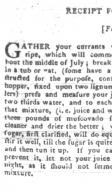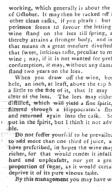[ Receipt for Making Currant Wine ]
Date: 1791/03/04
Source:
Nova Scotia Magazine
Institution: Nova Scotia Archives
| Source Origin: Nova Scotia Newspapers on Microfilm
| Reference: Microfilm Reels 8062, 8063
Detailed instructions for pressing, fermenting, aging, and racking currant wine originally published in the Hibernian Magazine. nn.165_66. Microfilm Reel 8063.
RECEIPT FOR MAKING CURRANT WINE.
[From the Hibernian Magazine]
GATHER your currants when full
ripe, which will commonly be a-
bout the middle of July; break them well
in a tub or vat, (some have a mill con-
structed for the purpose, consisting of a
hopper, fixed upon two lignum vitae rol-
lers) press and measure your juice, and
two thirds water, and to each gallon of
that mixture, (i.e. juice and water) put
three pounds of muscovado sugar (the
cleaner and drier the better; very coarse
sugar, first clarified, will do equally well)
stir it well, till the sugar is quite dissolved,
and then tun it up. If you can possibly
prevent it, let not your juice stand over
night, as it should not ferment before
mixture.
Observe, that your casks be sweet and
clean, and such as never have had either
beer or cyder in them, and, if new, let
them be first well seasoned.
Do not fill your casks too full, otherwise
they will work out at the bung, which is
by no means good for the wine; rather
make a proportionable quantity over and
above, that, after drawing off the wine,
you may have a sufficiency to fill up the
casks.
Lay the bung lightly on the hole, to pre-
vent the flies, &c. from creeping in. In
three weeks or a month after making, the
bung-bole may be stopped up, leaving on-
ly the vent hole open till it has fully done
W working,
working, which generally is about the end
of October. It may then be racked off into
other clean casks, if you please: but ex-
perience seems to favour the letting the
wine stand on the lees till spring, as it
thereby attains a stronger body, and is by
that means in a great measure divested of
that sweet, luscious taste, peculiar to made
wine; nay, if it is not wanted for present
consumption, it may, without any damage,
stand two years, on the lees.
When you draw off the wine, bore a
hole, an inch, at least, above the tap hole,
a little to the side of it, that it may run
clear of the lees. The lees may be either be
distilled, which will yield a fine spirit, or
filtered through a Hippocrates’s sleeve,
and returned again into the cask. Some
put in the spirit, but I think it not advisa-
ble.
Do not suffer yourself to be prevailed on
to add more than one third of juice, as a-
bove prescribed, in hopes the wine may be
richer, for that would render it infallibly
hard and unpleasant, nor yet a greater
proportion of sugar, as it would certainly
deprive it of its pure vinous taste.
By this management you may have wine,
letting it have a proper age, equal to Ma-
deira, at least superior to most wines com-
monly imported, and for much less money.
In regard to the quantity of wine in-
tended to be made, take this example, re-
membering that twelve pounds of sugar
are equal to a gallon of liquid.
For instance, suppose you intend to
make thirty gallons only, then there must
be,
8 gals. of juice, | 24 gls. mixtr.
16 of water, | 3 multid. by
____ | _____
24 gals. mixture,| 12)72 lb. sugar
6 gals. produced| equal to 6 gals. of
____ by sugar. | | liquid.
30 gallons.
And so proportionably for any quantity
you please to make.
The common cyder presses, if thorough-
ly clean, will do well in making large
quantities: the small hand screw press is
most convenient for such as make less.
N. B. An extraordinary good spirit for
medicinal and other uses may be distilled
from currant juice, by adding a quart of
melasses to a gallon of juice, to give it a
proper fermentation.
Download: Transcription | Images

